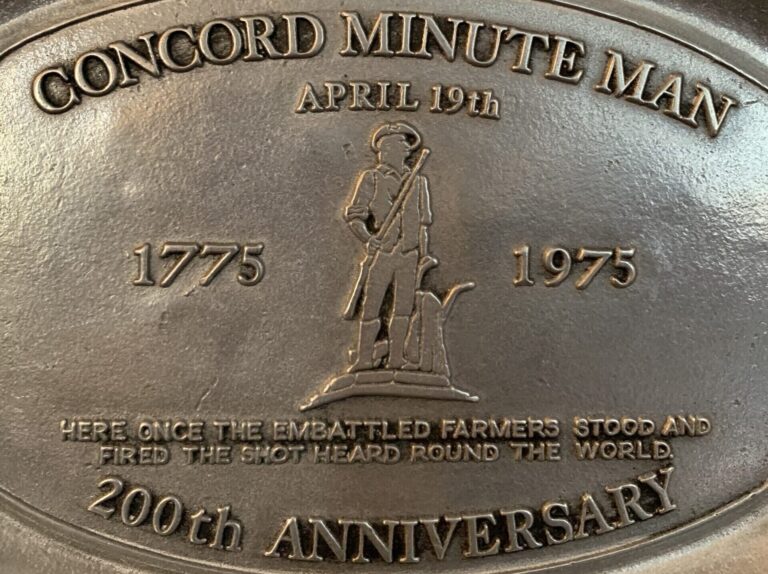The illusion that the subset of New England militia who called themselves “minutemen” were merely citizen soldiers with no military training is, well, just that. At least according to John R. Galvin in The Minute Men—The First Fight: Myths and Realities of the American Revolution (Potomac Books, Inc., 2006).
The Myth
The battles of Lexington and Concord on April 19, 1775—Ralph Waldo Emerson’s “shot heard round the world”—triggered eight years’ worth of carnage that included a civil war between rival factions and a world war between rival empires. (At the risk of belaboring the obvious, Emerson’s tag line is not to be confused with Bobby Thompson’s 1951 pennant-winning home run that propelled the NY Giants over the Brooklyn Dodgers—and which goes by the same moniker.) The public mindset is imbued with the notion that the storied salvo was the product of an impromptu uprising by a loosely connected network of farmers. And indeed that is what the British regulars probably expected to encounter when they sortied from Boston in search of rebel arms and ringleaders, specifically John Hancock and Samuel Adams, on that storied spring occasion.
General Thomas Gage, the Governor of Massachusetts and Commander of His Majesty’s Forces in North America, was unaware that the minutemen, and the militia of which they were a part, composed an army of nearly fifty regiments that was then nearing completion. This was no ragtag mob but rather a well-organized, well-armed, and relatively well-trained force of some 14,000 men.
The Reality
Galvin goes to great lengths to explain how the minutemen who opposed the British incursion actually relied on organizational concepts and a system of command and control that had emerged from a century and a half of constant warfare against the external threat posed by French, Canadian, and Indian intruders. He contends that these citizen-soldiers were not significantly disadvantaged in training or equipment relative to the British regulars invading their countryside and had more battle-tested small-unit leaders than the redcoats.
When it came to leadership, the militia included a considerable number of veterans from the French and Indian War whereas many of the King’s regiments, while boasting previous records of distinguished service, had not seen action for an extended period prior to 1775. In terms of training, the militia drilled and practiced their marksmanship on evenings and weekends throughout the winter of 1774-1775 while the British in Boston were heavily engaged in constructing housing and shops for their regiments and fortifying various locations. Perhaps most surprising, a substantial number of minutemen were equipped with bayonets.
Here is how these provincial warriors are portrayed in this chronicle; “The minute man was a member of a unit drawn from the regular militia and comprising a set percentage of that militia, specially trained, specially equipped, and required to assemble very rapidly and to be prepared at all times to march immediately into combat. A system of decentralized tactical control allowed officers at very low levels, usually company commanders, to exercise extraordinary authority, being permitted to assemble and march their men in time of danger without any orders from a higher command. The instant readiness of the units was supplemented by a wide net of inter-town alarm signals and messengers.”
Galvin argues that the story of the minutemen is inextricably intertwined with that of the militia. Some regiments included companies of both, and many were in a state of transition when the fighting erupted. In some cases, militia companies carried their minutemen on the same roll as the others in their ranks even though the minutemen were serving in a different unit, because this was regarded as only a temporary separation.
The Consequences
In this telling, the events of April 19 provided final confirmation of the efficacy of the provincial militia system in Massachusetts and represented the incipient step in the emergence of what became the Continental army. There were seventy-five companies of minutemen and militia based within a five-mile circle around the intruding British column, and almost every one assembled and set off to meet the threat that morning. “Not a soldier of Gage’s army understood how well these regiments were organized—not even Gage himself,” for the vast majority of regulars “simply refused to believe that an army had been created under their noses.”
The minutemen fought their way into the hearts of succeeding generations of Americans and became perhaps the definitive symbol of military preparedness for the country that emerged from the Revolutionary struggle. However, as Galvin reminds us, their combat-readiness entailed far more than merely keeping a firearm close by. It meant having a force with sufficient organization, equipment, and training to meet the perceived threat and being mentally prepared to take the field.
Those British soldiers who tangled with the colonials while retreating from Concord to Boston paid a heavy price to learn just how battle-ready the insurgents were. For General Gage, the expedition produced minimal results and yielded a grim body count: seventy-three regulars dead, 174 wounded, and twenty-six missing in action—a casualty rate of almost twenty percent among the 1,500 redcoats so engaged.
Indeed, from a British perspective, one might say the Massachusetts provincials were acting with (ahem) militias’ intent.
